Wall paints are a popular material for finishing work both among designers and those who decided to update the interior of an apartment or house on their own. After successfully choosing the color of the room, you can create a new optimally comfortable environment for life or work.
Modern materials for interior work are subject to high requirements in terms of safety (they should not contain substances that negatively affect human health), resistance to physical influences (light, moisture, temperature differences, friction, corrosion).
For different types of surfaces and premises, special products have been developed that have proven themselves best when used in certain conditions.
The range of paints and varnishes offered on the market for interior work is quite large, so it can be difficult to quickly find the right material. To make the right choice, you need to know a number of qualities that wall paints should have, regardless of the type.

What to look for
When purchasing paint for interior surfaces, it is recommended to study the following product parameters:
- safety or environmental compliance;
- resistance to environmental influences;
- ease of maintenance of the painted surface;
- hiding power (material consumption is associated with it);
- fast drying;
- thixotropy (change in viscosity with stirring);
- vapor permeability, gas permeability and hygroscopicity (the ability to pass vapors and moisture),
- material consumption per m2;
- dry residue.
When choosing a material for a living space, the safety of the coating becomes an important quality, not only directly during its application, but also during subsequent operation. Even after complete drying, some of the components that make up the paints are capable of releasing harmful substances when the air temperature or humidity rises. This applies to oil paints and nitro paints. Their use in residential areas should be minimized.
Resistance to physical impact is an important quality, especially if it is intended to be used for walls that will be washed frequently. Manufacturers provide information on the number of dry or wet cleaning cycles (depending on the type of material).
Wear resistance is indicated on the label in classes (1 to 5) or types (E1 to E5). The most abrasion-resistant - class 1 and type E1 (ultra-resistant to washing). They are used in bathrooms, dining rooms, kitchens, hallways. This is followed by wash-resistant (E2 and class 2) for the bedroom, nursery.
Grade 3 paints assume that the painted surface will rarely be wet cleaned. Classes 4 and 5 imply, respectively, either dry curing or a complete lack of exposure to the surface.
An important role in the choice of paint is played by hiding power and thixotropy. Hiding power is expressed in grams of material consumption per m2. In practice, you can often see on the label the number of layers for dense surface coloring (for example, 1 class - one layer, etc.). Typically, a higher grade paint can be economical due to its higher hiding power.
Thixotropy of a substance refers to the ability to decrease viscosity upon stirring and increase it at rest. Thixotropic paints do not smudge or drip from the brush when painting, which is very convenient when working with vertical surfaces.
An important parameter when choosing a material is considered to be vapor and gas permeability, as well as hygroscopicity. This is especially important for painting walls in a bedroom or in a children's room, which must allow water vapor and oxygen to pass through. The use of paints with good performance avoids the formation of moisture on surfaces, as well as the appearance of unwanted parasites (mold, mildew).
Consumption and solids figures help to calculate the amount of material required for painting. Consumption is divided by the dry residue and multiplied by 100. The resulting amount is required per 1 m2 of surface. Knowing the area of the walls, determine the mass (or volume of the material). The number of layers to be applied must be taken into account.
The choice of paint depends on the type of surfaces (concrete, wood, plaster, for PVC wallpaper for painting) and the tasks that are posed when creating a room design. However, there are a number of modern, versatile products that are suitable for various interior work.

The most popular types of paints and varnishes for walls
Wall paints, depending on the composition, are classified into three groups:
- emulsion (water-based, acrylic, silicone, polyvinyl acetate, latex);
- alkyd (enamel, oil);
- silicate.
Emulsion paints and varnishes are very popular among buyers. For surfaces with fairly aggressive operating conditions (corridors, kitchens and even walls in basements), silicate paints have proven themselves well.
Acrylic
Water-based interior paints, which contain acrylic resins, have become one of the most popular among buyers.
They have almost no smell, no release of toxic substances, high elasticity of the coating and strength, resistance to sunlight and moisture. The undoubted advantage of acrylic paints is the variety of colors.
Most products of this type are water-based, predominantly white. To obtain the desired shade, paintwork materials are tinted on equipment in a store or interior salon.
The advantages of acrylic paints are ease of maintenance of the finished coating, anti-corrosion properties. Drying is fast (1-3 hours). The coating is resistant to external factors (sunlight and friction). It has to be updated no more than once every 5-10 years. Also, a wall painted with acrylic paint does not attract dirt.
The disadvantages of acrylic dyes include a relatively high price. The budget version of such materials can be found in domestic manufacturers (Nevsky paints, Yaroslavl paints Admiral).
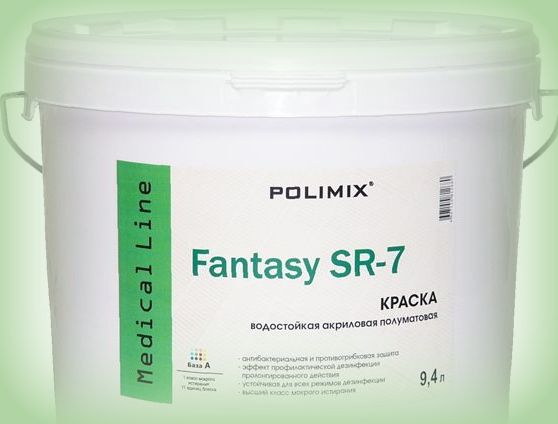
Polimix Fantasy SR7
This material is one of the most popular products in the category. Fantasy SR7 is used to paint walls in a wide variety of premises: from medical and health centers to children's institutions, apartments and institutions.
A distinctive feature of Fantasy is its disinfecting effect, which provides walls with long-term protection against microorganisms, mold and mildew. Initially, the material is white, but tinting is possible in both pastel and more saturated shades.
Benefits:
- high resistance to mechanical stress;
- resistance to treatment with chemical compounds and disinfectant solutions;
- does not turn yellow over time;
- has no smell;
- you can paint virtually any surface (including, it lays down on old oil paint and ceramic tiles);
- fast drying time (2-3 hours).
Disadvantages:
- complete polymerization (super-stability) is achieved only after 24 days;
- not recommended to be diluted with water;
- drops and traces of accidental contact on the surface are difficult to remove after drying:
- relatively high price.
Tikkurila HARMONY
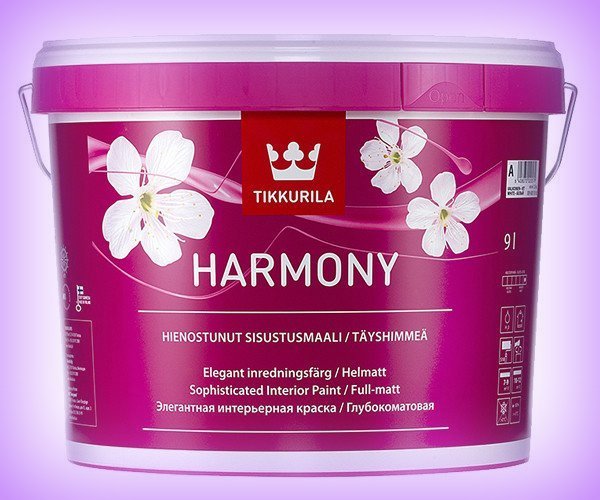
HARMONY from the Finnish company Tikkurila is one of the most popular products, including for self-painting walls, both machine and hand. Positive qualities are matte-silky appearance of the surface, no streaks when drying, low material consumption.
Designed for walls in living quarters (bedroom, living room, nursery, corridor, dressing room). The initial color is white, but can be tinted in pastel and bright shades.
Benefits:
- ease of application;
- even tone and matte effect;
- environmental friendliness;
- resistance to washing.
Disadvantages:
- relatively high price;
- there may be glossy spots after washing under oblique lighting;
- must be applied in several layers.
Colorex Projekt
Swedish paint for professional indoor painting.
Possesses good hiding power and good resistance to detergents. Recommended for indoor walls and ceilings in dry rooms. Can be applied to concrete, plaster, plaster and brick surfaces. It fits normally on fiberboard, chipboard.
Benefits
- ease of application, including with a roller;
- resistance to short-term action of detergents;
- resistance to mechanical stress;
- soft matt appearance of the finished surface, even with bright colors.
Disadvantages:
- high price.
Silicone water-based paints
Silicone is the most versatile water-based paintwork. They are based on silicone resins, and the solvent is water. Therefore, the environmental parameters for this type of materials are good. The lack of smell is also a plus.
Materials with silicone have good hiding power, and are even capable of hiding small and medium surface damage (up to 2 mm). A positive point is the good vapor permeability and hygroscopicity of the coatings with silicone, which makes it possible to use the materials in bathrooms and kitchens, in rooms with high humidity.
The advantages of silicone dyes are resistance to fading and temperature fluctuations. Finished coatings do not attract dust, are resistant to abrasion (including wet) and require renewal only once every 20 years.
Silicone emulsions, despite their relatively recent appearance on the Russian market, have become one of the most popular among buyers due to their advantages over other types of materials.
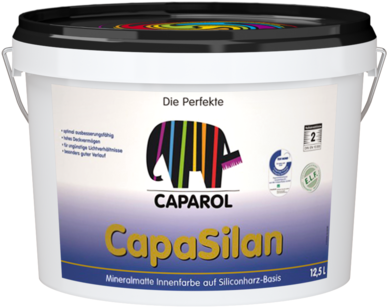
Caparol CapaSilan
High quality product from a well-known German company. It is intended for use when painting walls in public institutions (from medical centers to cafes), residential apartments and houses. It can be applied not only to walls, but also to the ceiling, as it does not drip and can hide minor damage.
Recommended for application in rooms with high humidity: bathrooms, kitchens.
Benefits:
- coating quality;
- hiding power;
- moisture resistance;
- resistance to mechanical stress.
Disadvantages:
- requires experience in application;
- may have high viscosity, which reduces the uniformity of application;
- high price.
Tikkurila Euro Extra 20
Finnish product that is resistant to mechanical stress and provides a quality finish. In addition, Euro Extra is environmentally friendly, dries relatively quickly and does not have a strong odor. It is intended for use in living quarters in rooms where walls are subject to periodic cleaning with detergents.
Benefits
- suitable for damp rooms (kitchen, bathroom);
- resistant to mechanical stress;
- easy to apply.
Disadvantages:
- requires applying a foundation under it;
- high price.
Latex water emulsion
For use on textured wallpaper, latex paints are considered one of the best. They include latex, which creates a strong film on the treated surface. This water-repellent film is capable of masking small defects. The materials are also classified as washable (can be cleaned with soapy water) and abrasion resistant.
In addition, the drying time is short and the work can be completed in just 1 day. Environmental indicators are also high: no emissions of harmful substances and odor, high vapor permeability.
The latex coating is elastic and durable. Consumption per 1 m2 is quite low (100-200 ml when applied in one layer). However, their color scheme is paler than the acrylic variety - for latex paints, tinting is provided only in pastel colors.
Flugger Flutex
Flugger Flutex 2S is designed for walls in residential premises, including those with intensive cleaning of surfaces (kitchen, corridor). The material contains a lot of PVA and has good hiding power. Flugger Flutex results in a uniform, matte finish with rich color, non-glare in bright light.
Flugger Flutex can be used not only for walls but also for ceilings. The product has been awarded the “ECO” environmental label. Well suited for re-painting or restoring surfaces.
Benefits:
- environmentally friendly;
- low material consumption;
- multifunctionality;
- washable.
Disadvantages:
- dries too quickly (streaks may remain);
- requires a primer;
- is not cheap.
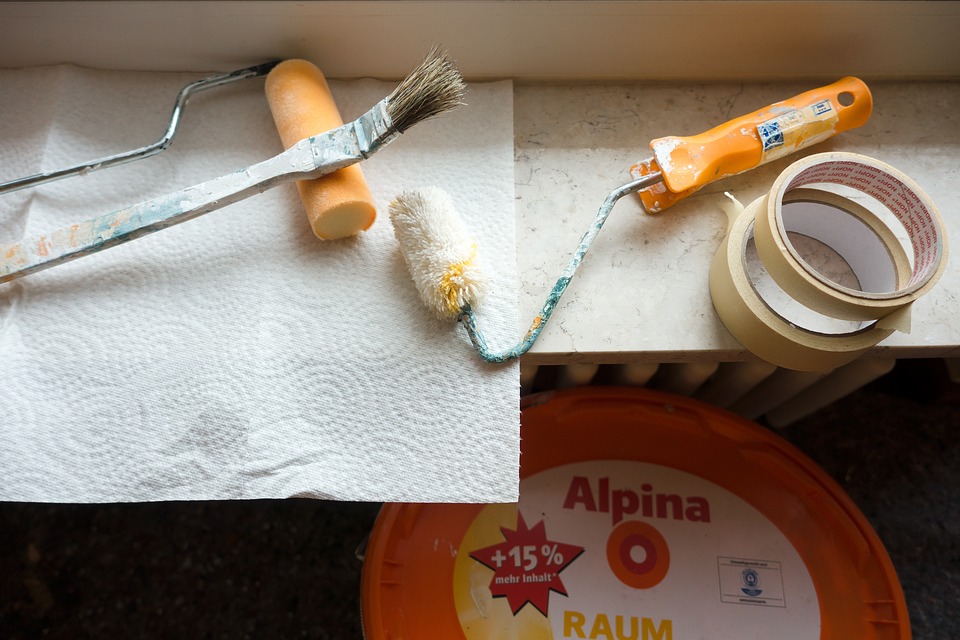
Alpina Expert Mattlatex
Alpina brand products are one of the most popular among DIYers in Germany. Ideal for fast painting of large surfaces. Recommended for application on surfaces with plaster, old paint, paintable wallpaper.
Differs in environmental friendliness, resistance to washing. When applied, it hides minor surface imperfections (scratches, irregularities).
Benefits
- excellent covering ability;
- easy to apply and lies flat;
- can be tinted by hand;
- easy to clean off tools.
Disadvantages:
- requires compliance with the temperature regime during staining and drying.
Silicate paints
Silicate painting materials contain liquid glass with additives of chalk, talc and silicates. The advantages of this group of products include a good combination of vapor permeability and moisture resistance.
This type of materials is resistant to ultraviolet light, temperature drops. The term of renovation of repairs with silicate paintwork materials is over 10 years. Walls must be cleaned and dried before painting. Cannot be applied to old paint (especially organic paint).
Silicate paintwork materials are intended for painting walls in the kitchen, in the corridor. They can be applied to walls in basements and semi-basements.
When carrying out painting work, the use of eye and skin protection is required due to the presence of aggressive components.
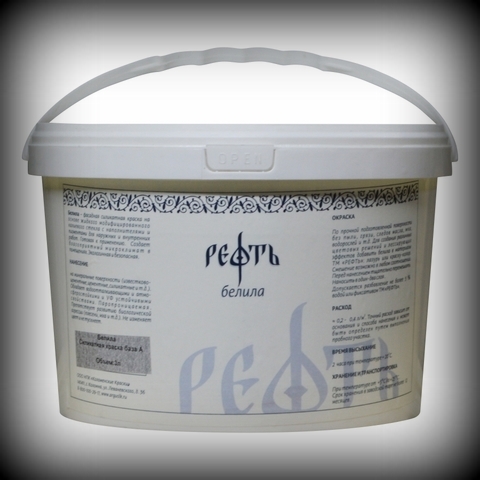
White TM REFT
A domestic product based on liquid modified glass. The material is versatile - suitable for both outdoor and indoor use.
Based on the base color, you can create shades of different saturation using tinting. Recommended for application on various types of plastered and putty surfaces.
Benefits:
- fills in irregularities;
- resistant to ultraviolet light and aggressive substances;
- without smell;
- dries quickly;
- low price.
Disadvantages:
- do not paint at high air temperature and humidity.
AKTERM KM0 - NG
A distinctive feature of this material is resistance to burning. Therefore, it is recommended for use in premises with increased fire hazard (kitchens, industrial premises, cinemas, clubs, hotels, escape routes in case of fire).
In addition, AKTERM is resistant to mechanical stress. Easy to apply to concrete walls, drywall, plaster, brickwork, fiberglass wallpaper, wood.
Benefits:
- environmental friendliness;
- fire resistance;
- resistance to damage;
- the ability to apply to a large number of materials;
- low price.
Disadvantages:
- requires staining in several layers;
- the full strength of the coating is gained in 28 days.
Top brands and manufacturers
When choosing wall paint, you should pay attention to well-established manufacturers, since unknown companies can produce a low-quality product.
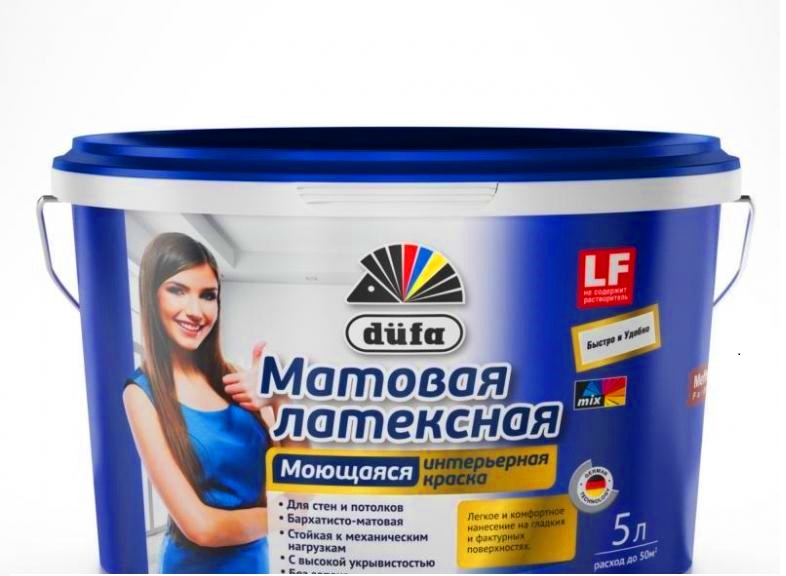
Buyers speak best about manufacturers from Germany and Finland (Alpina, Dufa, Tikkurila, Finncolor), which are popular in European countries. Good price-quality ratio for Polish products under the Sniezka brand. The Swedish company Beckers presents on the Russian market a universal paint for various surfaces that meets world eco-standards.
The Turkish brand Marshall has also proven itself well, especially the Export-7 product. It has good performance properties, and the finished coating normally withstands cleaning with chemical detergents. An additional advantage of Marshall products is economical consumption (l / 12 m2).
Russian companies Eurolux, Nevsky paints, Yaroslavsky paints, Admiral and many others also offer quality materials at relatively low prices.
With the correct selection of paintwork materials for repairing the walls of premises, taking into account all the features of subsequent operation, you can get a high-quality coating at a relatively low price, which will last for many years.












